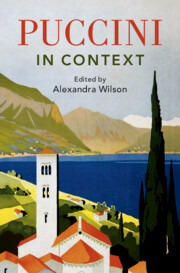Book contents
- Puccini in Context
- Composers in Context
- Puccini in Context
- Copyright page
- Contents
- Figures
- Table
- Notes on Contributors
- Preface
- Part I Formative Influences
- Chapter 1 Forefathers and Teachers
- Chapter 2 Contemporaries and Competitors
- Chapter 3 Puccini and Women
- Part II Puccini’s Places
- Part III Influences and Interests
- Part IV Bringing Puccini to the Stage
- Part V Image and Reputation
- Part VI Puccini through a Political Lens
- Part VII Interpreting Puccini
- Part VIII Legacy
- Bibliography
- Index
Chapter 2 - Contemporaries and Competitors
from Part I - Formative Influences
Published online by Cambridge University Press: 31 August 2023
- Puccini in Context
- Composers in Context
- Puccini in Context
- Copyright page
- Contents
- Figures
- Table
- Notes on Contributors
- Preface
- Part I Formative Influences
- Chapter 1 Forefathers and Teachers
- Chapter 2 Contemporaries and Competitors
- Chapter 3 Puccini and Women
- Part II Puccini’s Places
- Part III Influences and Interests
- Part IV Bringing Puccini to the Stage
- Part V Image and Reputation
- Part VI Puccini through a Political Lens
- Part VII Interpreting Puccini
- Part VIII Legacy
- Bibliography
- Index
Summary
This chapter examines Puccini’s relationship with the other young Italian composers of his generation – who came to be known as the giovane scuola italiana – and demonstrates how they were forced into a sometimes antagonistic rivalry with one another. All of these young men were in competition to attract the attention of the major Milanese publishing houses of the day, Ricordi and Sonzogno, and all wanted to be crowned successor to Verdi as Italy’s new national composer. The chapter discusses the composition competition launched by the Sonzogno firm, Puccini’s unsuccessful entry with his opera Le Villi, and Mascagni’s triumph with Cavalleria rusticana. The chapter examines how many of the young composers of the day turned to the verismo genre of opera and discusses the careers of figures including Catalani, Franchetti, and Leoncavallo. Puccini’s process of selecting literary sources to set is considered, with the author showing the importance of rivalry as a creative stimulus for the composer.
- Type
- Chapter
- Information
- Puccini in Context , pp. 10 - 18Publisher: Cambridge University PressPrint publication year: 2023

